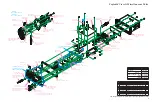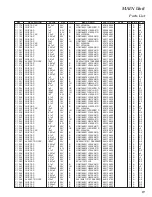
7
Circuit Description
Reception and transmission are switched by 8-bit MPU
IC
Q2004
(
UPD78F0395GC
) on the CNTL Unit. The re-
ceiver uses double-conversion superheterodyne circuit-
ry, with a 21.4 MHz 1st IF and 450 kHz 2nd IF. The 1st
local is produced by a PLL synthesizer, yielding the 21.4
MHz 1st IF. The 2nd local uses a 21.85 MHz crystal oscil-
lator, yielding the 450 kHz 2nd IF. The 2nd mixer and other
circuits use a custom IC to convert and amplify the 2nd IF
and detect FM to obtain demodulated signals. During
transmit, the PLL synthesizer oscillates at the desired fre-
quency directly, for amplification to obtain RF power out-
put. During transmit, voice modulation is applied to this
synthesizer. Transceiver functions, such as TX/RX control,
PLL synthesizer settings, and channel programming, are
controlled using the MPU.
Receiver
Incoming RF signals from the antenna connector are de-
livered to the MAIN Unit, and pass through a low-pass
filter (LPF) consisting of coils L1001 & L1002 and capaci-
tors C1003, C1011, & C1024, and antenna switching di-
ode
D1004
(
L308CCB
) for delivery to the receiver front
end.
Signals within the frequency range of the transceiver are
passed through a bandpass filter consisting of coils L1006
& L1008 and capacitors C1027, C1036, & C1059, before RF
amplifier
Q1022
(
3SK294
).
The amplified RF is passed through a bandpass filter con-
sisting of coils L1022, L1026, & L1027 and capacitors
C1145, C1150, C1115, C1159, C1170, C1174, & C1179. The
pure in-band input signal is delivered to the main 1st mixer
Q1028
(
3SK131
).
Buffered output from the MAIN VCO is amplified by
Q1018
and
Q1019
(both
2SC5006
) and low-pass filtered
by coils L1009 & L1011 and capacitors C1064, C1071, &
C1076, to provide a pure 1st local signal between 134.625
and 136.025 MHz for delivery to the main 1st mixer.
The 21.4 MHz 1st mixer product is passed through the
monolithic crystal filter XF1001 (±6.5 kHz BW), and is
amplified by
Q1036
(
2SC4400
).
After that, it delivered to the input of the FM IF subsystem
IC
Q1029
(
TA31136FNG
). This IC contains the 2nd mix-
er, 2nd local oscillator, limiter amplifier, FM detector, noise
amplifier, and squelch gates.
The 2nd local in the FM IF subsystem IC
Q1029
(
TA31136FNG
) is produced from crystal X1001 (21.850
MHz), and the 1st IF is converted to 450 kHz by the 2nd
mixer and stripped of unwanted components by ceramic
filter CF1001.
After passing through a limiter amplifier, the signal is
demodulated by the FM detector. Demodulated audio
from the FM IF subsystem IC
Q1029
(
TA31136FNG
) is
amplified by
Q1038
and
Q1033
(both
2SC4154
). The am-
plified signal is passed through the AF mute switch
Q1031
(
2SK2035
) and the front panels volume control. The ad-
justed audio signal is delivered to the AF power amplifi-
er
Q1039
(
LA4425A
).
The amplified audio signal is delivered to the 8 Ohms in-
ternal loudspeaker and external Speaker terminal in the
accessory cable.
PLL Synthesizer
The 1st Local signal maintains stability from the PLL syn-
thesizer by using a 21.850 MHz reference signal from crys-
tal X1001. PLL synthesizer IC
Q1026
(
TB31202FNG
) con-
sists of a prescaler, reference counter, swallow counter,
programmable counter, a serial data input port to set these
counters based on the external data, a phase comparator,
and a charge pump.
The PLL synthesizer IC divides the 21.850 MHz reference
signal by 1748 using the reference counter (12.5 kHz com-
parison frequency).
The VCO output is divided by the prescaler, swallow
counter and programmable counter. These two signals are
compared by the phase comparator, and applied to the
charge pump.
A voltage proportional to their phase difference is deliv-
ered to the low-pass filter circuit, then fed back to the VCO
as a voltage with phase error, controlling and stabilizing
the oscillating frequency. This synthesizer also operates
as a modulator during transmit.
The VCO consists of
Q1019
(
2SK210GR
) and varactor di-
odes
D1009
and
D1011
(both
HVU359
), which oscillates
at 21.4 MHz below from the receiving frequency while
receiving, and oscillates at the fundamental transmit fre-
quency during a transmit with direct frequency-modula-
tion using varactor diode
D1010
(
1SV214
). The VCO out-
put passes through buffer amplifier
Q1018
and
Q1017
(both
2SC5006
) to obtain stable output, then applied to
the 1st mixer of while receiving, and to the driver ampli-
fier
Q1008
(
2SC5006
) during a transmit.
The DC supply for the VCO is regulated by
Q1016
(
2SC4154
).
Summary of Contents for Eclipes DSC GX1000S
Page 4: ...Exploded View Miscellaneous Parts 4 Note ...
Page 5: ...Block Diagram 5 ...
Page 6: ...Block Diagram 6 Note ...
Page 14: ...14 MAIN Unit Note ...
Page 24: ...24 Note MAIN Unit ...
Page 31: ...31 ...








































